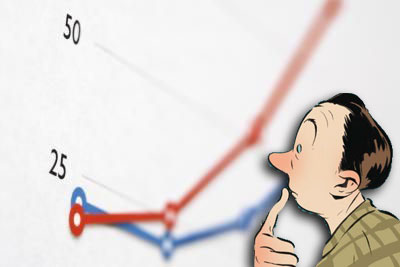Throughout human history people have been driven by fear and hatred in response to the things that they don’t understand. Examples include the Salem Witch Trials, human sacrifice in the service of vengeful gods, and modern political polling. Today I will endeavor to demystify the last of these without putting you to sleep or making your head hurt. A broader understanding of what polls are, what they aren’t, and the function they serve is extremely valuable to anyone who wishes to objectively understand the election process.
Before I can get into the specifics of the 2016 primary cycle, it is important to establish some basic facts about the art/science-ish nature of polling. I will try to make this part as painless as possible and keep the statistical jargon to a minimum so stick with me.
Polling is predicated on math, but is not purely mathematical. All sorts of biases creep in that can skew the results. These include the way that questions are asked, the means of reaching voters (online, landline, cell, canvassing), and how the model of the electorate is constructed (18% Latino, 9% women over 65, moderately vs. very conservative, etc.). All of these things are judgment calls based on how the electorate has looked in past election cycles under similar circumstances. Factors that can affect this include whether it is a presidential year, primary vs. general, and the candidates themselves. For example, the polling model if Obama is running will reflect higher African American turn-out than it will for a race involving Hillary Clinton.
These assumptions mean that the top line of polls (the numbers we all see on the news) can vary widely depending on how the electorate is defined and how the poll is constructed. The takeaway for a voter, activist, or donor seeing these numbers should be to see if other polls tell a similar story or show a large disparity and to look at the trend over several polls or an aggregation of polls such as the Real Clear Politics polling average or Nate Silver’s fivethirtyeight blog in order to draw meaningful conclusions.
These organizations don’t do any polling themselves. Instead they take several recent polls and average them out. By doing so, bias that has slipped into any given poll is diminished and a more accurate picture emerges. In 2012 Nate Silver correctly predicted the election outcome in all 50 states using this method.
The next thing to remember is that a poll does not predict the likely winner of a race, certainly not 5 months out, but rather indicates where voters are leaning given what has happened up to that point, especially what has happened recently. At this point in 2008, Rudy Giuliani was winning the Republican primary in the polling. This reflected his standing at that moment, but said nothing about who the eventual nominee would be.
It is like taking a snapshot of a horserace as the horses round the first bend. This gives pundits something to talk about, donors some indication of where the smart money should go, and candidates a sense of what they need to do to be competitive; but in no way predicts the eventual winner, outside of the last days of the campaign.
All of that said, even the aggregations of polls can be wrong when a structural bias creeps in. This is the results of what pollsters call an informational cascade. In other words, pollster one and two are assuming that evangelicals will make up 16% of the electorate, so pollster three and four use the same assumption, but it turns out that evangelicals make up 19% of the voters on Election Day. This is what happened in the 2014 midterms and the recent British election. All of the pollsters failed to recognize the intensity of right-leaning voters which shifted some races just enough to turn close elections into landslides. Because the bias was system wide, averaging polls failed to suss it out.
All of which brings us to 2016 and how we should be viewing the Republican primary polls at this moment. Taking the Real Clear Politics average we see that Donald Trump is at 23.3%. But what does that actually tell us? It tells us that within the last few days 23.3% of Republicans polled indicate that they support Donald Trump. However this says nothing about whether or not Donald Trump is likely to be the nominee. The more valuable piece of information is what the polling average says over time.
When we look at Donald Trump’s polling average for the last two weeks, we see that his poll support peaked on September 18 at 30.5% and has declined 7.2% subsequently. In other words 7 out of 100 fewer likely Republican primary voters are saying they support Donald Trump now than they did two weeks ago. As a percentage of the GOP primary electorate, Trump is trending downward and has lost about one quarter of the support he enjoyed on September 18th, based on an aggregation of several polls.
Turning to Rand Paul, we see that his RCP polling average now sits at 2.3%, down from 3.3% on September 18th. During that period he has lost about a third of his already meager support. In this way we see that the polls reflect the news that we are all seeing about the problems with his campaign and the many editorials declaring him dead.
Does this mean that he won’t be the Republican nominee? No, candidates can come back by changing the dynamic which changes the coverage, which changes the opinions of the voters being polled. Bad polling does reflect the challenges that the campaign faces in terms of getting traction, changing the dynamic, and becoming competitive. Donors are less likely to give money, journalists are less likely to give coverage, and persuadable voters are less likely to express support to a candidate that doesn’t look like a potential winner. In this way, the polling both reflects and perpetuates another type of informational cascade which is the perception of the standing and likely future success of any candidate.
As a political observer, we should all recognize what the polls are and what they are not. However, we must be careful not to impose our own biases in how we look at them. Many of Rand Paul’s supporters want to believe there is a large pool of untapped and un-polled voters out there just waiting to swamp the ballot box on Election Day. There are not. For the reasons described above along with other factors such as closed primaries that prevent those not already defined as likely Republican voters from casting ballots, the polling tells us that if the election were held today, Paul would almost certainly be within a point or so of what the polls indicate is his current level of support. The polls do not tell us what his support will be in February, but they give us a good indication of where his challenge lies between now and then.





2 comments
… [Trackback]
[…] Info on that Topic: thelibertarianrepublic.com/polling-101-what-every-informed-voter-should-know/ […]
… [Trackback]
[…] Read More Information here to that Topic: thelibertarianrepublic.com/polling-101-what-every-informed-voter-should-know/ […]